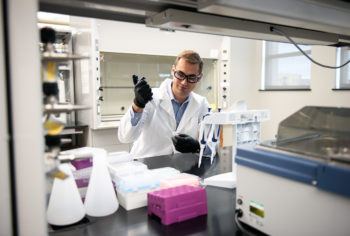Texas A&M Biologist Finds Life Purpose In Spinal Cord Injury Research

Texas A&M University biologist Dylan McCreedy was only 18 months old when he lost the hearing in his right ear, the result of a near-fatal case of spinal meningitis.
The grueling ordeal hospitalized him for weeks, and even though he was too young at the time to remember any of it, the resulting impairment that McCreedy lives with to this day became a constant reminder of the gravity of neural afflictions, most of which can result in devastating, often life-altering debilities. But it also inspired his life’s work to better understand them.
As an assistant professor and TIRR Foundation Fellow in the Texas A&M Department of Biology, McCreedy specializes in researching the acute inflammation that occurs immediately following spinal trauma and its effect on wound healing — details that could lead to improved functional recovery for the approximately 300,000 people in the U.S. affected by spinal cord injury, according to the National Spinal Cord Injury Statistical Center.
“I was really interested in the nervous system and how I had lost that hearing function,” McCreedy said. “That led me to spinal cord injuries and the loss of function as a whole, both motor-sensory and autonomic function that individuals with those types of injuries tend to experience. I wanted to see how we can potentially prevent that damage by targeting early inflammation or help restore that damage after it’s already occurred and repair the injured spinal cord.”
In August, McCreedy was awarded a $1.9 million National Institutes of Health grant administered through the National Institute of Neurological Disorders and Stroke to support a five-year study focusing on the role neutrophils play in spinal cord injuries.
Neutrophils, which are the most abundant type of immune cell found in human blood, are believed to be among the first lines of defense at sites of infection and tissue damage. The McCreedy Lab will investigate the mechanisms by which neutrophils are recruited to the spinal cord after injury and how their receptors regulate their healing properties.
The goal, McCreedy says, is to use the findings from the study to advance novel targeting technologies and therapeutic strategies to aid in the long-term neurological recovery of damaged spinal cords. The resulting data also can be applied to treating inflammation observed in other central nervous system afflictions or disorders.
“We’re very excited about the NIH grant we just received,” McCreedy said. “The results of this study will allow us to study promising FDA-approved drugs to determine how their delivery to damaged areas can be improved in order to better benefit those with spinal cord injuries.”
The neutrophil study will run in conjunction with the McCreedy Lab’s continued efforts in one of their main areas of specialization, developing advanced three-dimensional imaging techniques to produce high-quality images of whole spinal cords that will allow scientists to quickly assess neural circuit damage. Using lightsheet microscopy, the team is able to observe spinal cord tissue in its natural structure with higher optical resolution and greater depth.
“Typically, when you study the injured spinal cord, you have to take the tissue and either dissociate it to look at the individual cells or take sections of it so that you can produce an image throughout the spinal cord,” McCreedy said. “With our lightsheet microscope, we can turn the spinal cord optically transparent so that we can see all the way through its intact state.”
McCreedy earned his Ph.D. in biomedical engineering from Washington University in St. Louis in 2013 and completed postdoctoral fellowships at the University of Michigan/Northwestern University and the University of California-San Francisco. He was recruited to Texas A&M in 2019 as part of a cluster hire made possible through a partnership with The Institute for Rehabilitation and Research (TIRR) Foundation to kickstart a spinal cord injury research initiative. In addition, he is an affiliated member of the Texas A&M Spinal Cord Initiative and the Texas A&M Institute for Neuroscience
In March, McCreedy was one of 55 early-career scientists from the U.S. and Canada named as fellows for a new Scialog: Advancing Bioimaging initiative aimed at bolstering interdisciplinary collaborations to develop the next generation of imaging technologies.
“Joining Texas A&M was a great opportunity to come to an area that was rich in spinal cord injury research and expertise,” McCreedy said. “I’m fortunate to be able to benefit and contribute to this collaboration.”
This article by Chris Jarvis originally appeared on the College of Science website.





